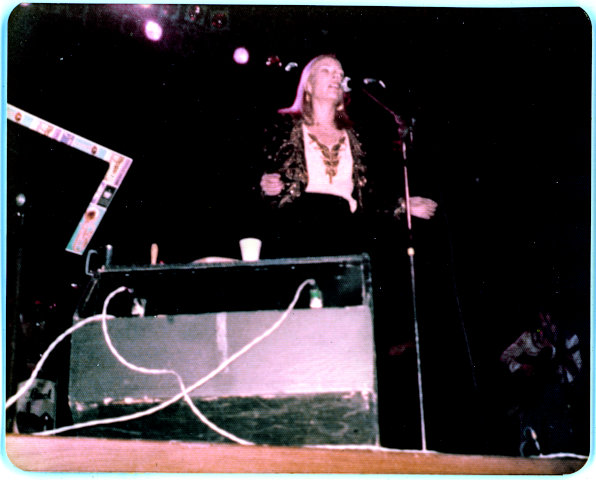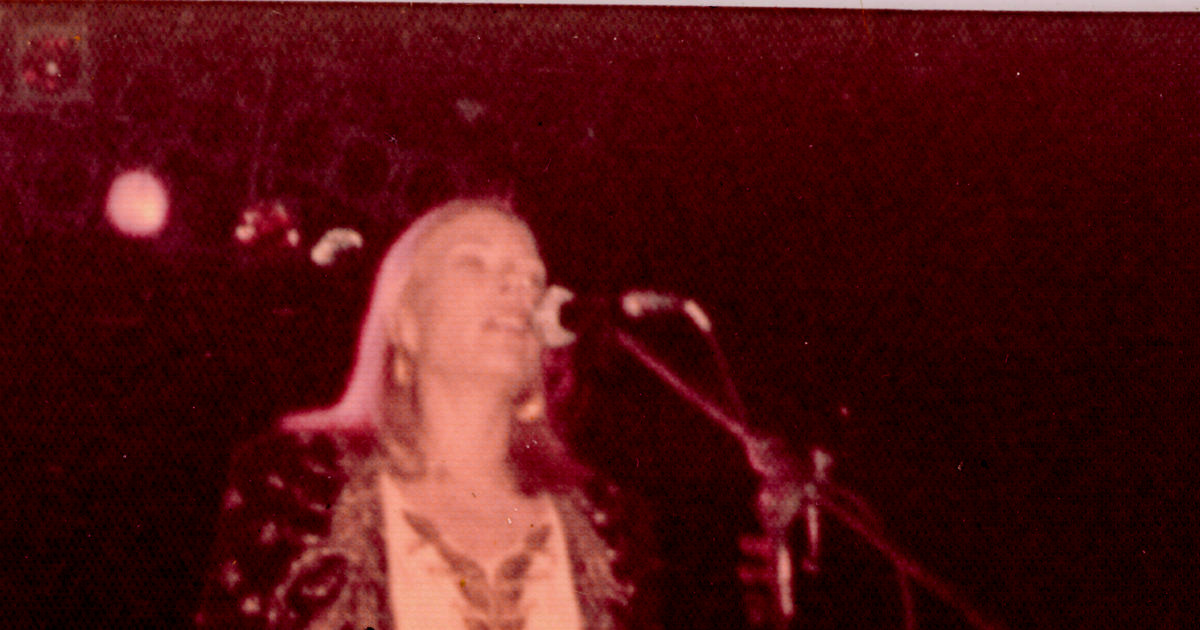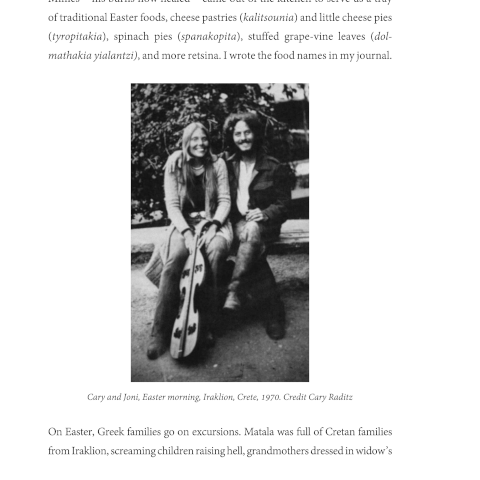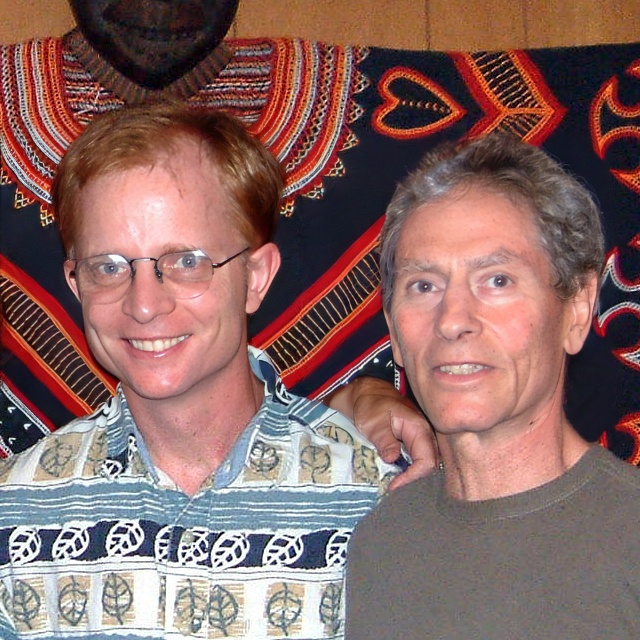It’s 2009 and my sister-in-law and I are educating my brother Matt about Joni Mitchell. Matt is familiar with both kinds of music: Willie and Nelson. Deanne is telling a second-hand story about Joni Mitchell – a story she and Matt had both heard told from the stage by Lucy Kaplansky who had performed Mitchell’s song “Carey.”
“Lucy said that Joni had this wild relationship with a guy named Carey, the guy in the song…”
I begin to interrupt, too excitedly, “Actually…” Deanne pauses and looks at me, probably annoyed. “Sorry,” I say. “Tell your little story, and then I’ll blow your mind.”
She finishes her sentence: “…and now he’s a stockbroker.”
“Not exactly,” I say. And I proceed to blow her mind.
A Little Bit About the Song
The song “Carey” by Joni Mitchell is a strange one. It’s an upbeat song about wanderlust and homesickness. It manages to be sad and joyous. It’s a bittersweet goodbye song; a got-to-be-rambling-on song delivered to a bad boy named Carey – or rather: Cary.

Throughout her public life Mitchell has been romantically connected to a handful of name-brand musical icons. But this “Carey” guy is not a musical icon. Who he is has been the subject of a lot of speculation over the years. “Carey get out your cane…” begins the chorus. And among the fan theories, there are those who speculate that Carey is a drug supplier; that “cane” is a reference to cocaine. Seriously. To paraphrase Freud: “Sometimes a cane is just a cane.”
For fans willing to pry into Mitchell’s personal business, answers about Cary have been available for a long time. But I try not to care about the personal lives of entertainers. I didn’t care. I didn’t pry. I didn’t have to.
Coffee with Cary
I’ve known Cary Raditz since 1992. He was and is an international financial strategist, often working with international NGOs. We worked on the same coffee project in Cameroon when I was a Peace Corps Volunteer. I was 29 years old, but a greenhorn at international work. It was my first time visiting any country that didn’t share a border with the United States. I was feeling my way into Cameroonian culture, and figuring out what exactly I was supposed to do for work.
Six months into my unfocused beginnings in Africa, Cary arrived along with two other seasoned international consultants. Cary was sharp-witted, confident, and unlike me and my volunteer cohort, he seemed to have landed in Cameroon pre-loaded with everything he needed to know. Those three pros helped me and my co-worker volunteers figure out what we were supposed to do.
A Nod to the Photo on the Wall
Early, while getting to know Cary, I visited the rented house where he lived with his family, high on the cliffs overlooking the city of Bamenda – “Up-Station” they call it. The house was decorated with artifacts from their work and travels, including a framed black-and-white photo on the wall of a younger version of Cary with Joni Mitchell.
I remember Cary gesturing to that photo with a head nod, wanting me to see it. He wanted me to know there was a story to tell.
It may have been the same photo now found on the cover of his memoir, Carey: Genesis of the Song in which Cary has written about his relationship with Mitchell, and his relationship with the song that bears his misspelled name, and more.
Actually, he has written a lot more: In his 300-page memoir Cary spends more than the first half of the book chronicling events in his life before he ever laid eyes on Joni Mitchell. It’s roughly the same ratio into the film Jaws before we finally see the shark for the first time. But “Carey” does not at all have that kind of build up. While watching the first act of Jaws, you never forget that a shark is coming. “Carey” can almost make readers forget that they (probably) got this book for the Joni part of the story. I’m okay with that, because I find Cary at least as interesting as Joni.
Plus I’d already heard the outlines of his Joni story, directly from the source – directly from Cary: How he was living in a cave in Greece with free-spirited hippies and freaks. How he met Joni. This is the outline I triumphantly gave to my brother and sister-in-law when the opportunity arose.
But not everyone was invited to hear those stories. I have heard accounts of mutual acquaintances being rebuffed when they approached Cary to draw out his Joni stories. It seemed like, “We don’t talk about Joni.” Unless you happened to catch Cary in the mood.
In recent years, Cary has been increasingly in the mood to talk. He’s given interviews to All Things Considered, on NPR, The Wall Street Journal, and The New Statesman. And now he’s talking in his self-published book.
But back to me…
The Cameroon Project
Don’t get me started talking about the coffee project on which Carey and I worked in Cameroon. Too late! As briefly as possible: It was contentious. The foreign interlopers – Cary, me, and about 20 others – were caught between two opposing sides.
On one side were the prosperous Cameroonian coffee barons – the Big Men – wanting to protect their lucrative spots in the coffee supply chain. On the other side were the smallholder coffee farmers who had been newly unshackled from the laws that had bound them to sell exclusively to the cooperatives controlled by the Big Men. The farmers had been given the right to look for better offers. They just didn’t know it yet.
My job was to teach the farmers about their rights and how to flex those rights. The Big Men resented that, and they pushed back.
And that’s the context for how I came to work with Cary – as concisely I’ve ever been able to tell it.
Cary-isms
Cary can be cantankerous, I learned, even mean, as the song says. We were sometimes on opposite sides when it came to how to approach the project in Cameroon. More often, I found his counsel really helpful. Often his advice or observations were delivered as mischievous one liners or aphorisms.
Such as:
“When people are confused, they have a tendency to side with power.”
That Cary-ism led helped me realize that I couldn’t achieve all of my work simply by educating farmers. The Big Men were actively contradicting what the volunteers were saying – intentionally cultivating confusion. I had to win over at least one of the Big Men. When I did, the Big Man stopped contradicting me, and instead began supporting my work. And immediately I began to have progress with farmers under his sphere of influence.
This nugget of wisdom still informs how I view politics.
“Repeated exposure to the trauma robs it of it’s significance.”
This was Cary’s way of saying “suck it up” after I whined and vented my frustration over being repeatedly called “ssarra” – a local word for “white man.” It was starting to interfere with my ability to enjoy my time in Cameroon. (See: “Tsara is not Ssarra and Other Observations on Language“)
The book is full of moments like that – erudition delivered with a smirk. Just the way I remember him.
A Spiritual Blowhard
This is Cary’s first book. But the voice and style seem familiar. If you’ve read Jack Kerouac, Hunter S. Thompson, or Robert M. Pirsig, you’ll feel their influence.
In some ways, “Carey” is difficult to read. The younger version of Cary is not someone I would have liked: grumpy, nasty, self-superior, controlling, womanizing. Reading it, I’m reminded of another episodic, semi-biographical, horndog journey: “The Fool’s Progress” by Edward Abbey. When I read that book, every few pages I found myself shouting at the text, “No! Don’t! What the fuck is wrong with you?”
Cary seems to hear the question, and often answers, “I don’t know what possessed me.”
And (as with Abbey) in addition to the wild, reckless, blowhard side, there’s the spiritual, intellectual, and philosophical side that comes through in “Carey.” The duality is hard to reconcile. It’s a duality I’ve found in other high-performing people, and it can drive me nuts if I let it.
If you’ve ever crossed paths with someone who left you wondering, “Why are they like that?” then this book is for you – as long as that person is Cary Raditz.
And Joni Mitchell fans will probably find it very interesting, I suppose. To be honest, I’m still reading it. I’m not even to the part where we see the shark. But I want to help Cary succeed with his book. Plus, “It’s coming on Christmas. They’re cutting down trees.”
Featured Photo Credit: Thomas Hawk (CC-BY-NC)


